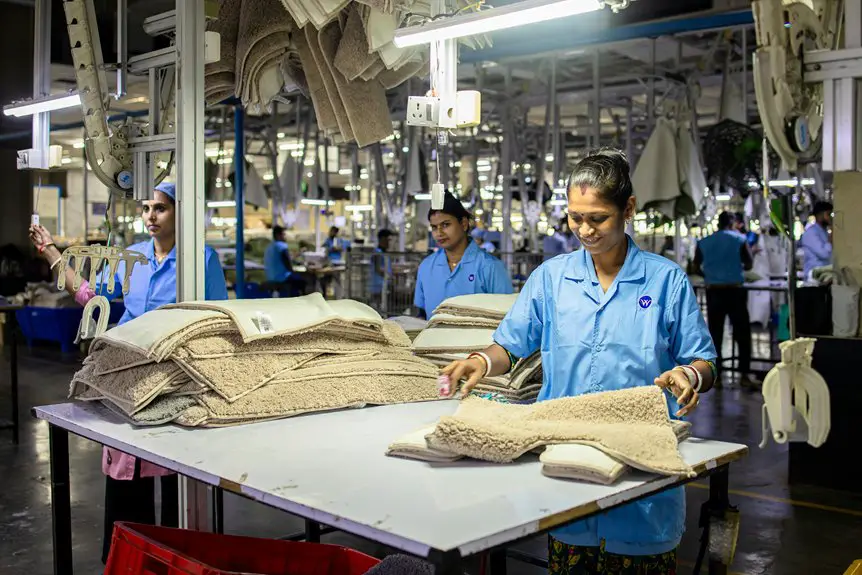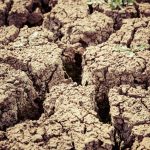Imagine a vast, barren landscape where once-thriving ecosystems have crumbled under the weight of cashmere goats. This isn’t just a distant reality; it’s happening now, and the impact is staggering. The water needed for cashmere production is astronomical, leading to severe scarcity in vulnerable regions. But that’s just the beginning. What does this mean for the future of luxury and our planet? Let’s explore the deeper implications of this crisis.
Table of Contents
Key Takeaways
- Cashmere production consumes around 20,000 liters of water per kilogram, contributing to severe water scarcity in vulnerable regions.
- Overgrazing by cashmere goats leads to soil erosion, biodiversity loss, and desertification, threatening ecosystems and agricultural productivity.
- Toxic chemicals from cashmere processing pollute water sources, harming aquatic life and exacerbating local food security issues.
- Cashmere’s environmental footprint is larger than alternatives like organic cotton and Tencel, which require fewer resources to produce.
- Sustainable farming practices and consumer awareness are essential for mitigating cashmere’s environmental impact and promoting ethical sourcing.
The Water Footprint of Cashmere Production
While you might think of cashmere as a luxurious fabric, the reality is that its production comes with a hefty water footprint.
To produce just one kilogram of cashmere, it takes around 20,000 liters of water. This staggering amount often leads to water scarcity in regions where cashmere goats are raised.
Producing a single kilogram of cashmere demands approximately 20,000 liters of water, exacerbating regional water scarcity.
Farmers rely on vast amounts of water for the goats’ grazing needs and to support the delicate ecosystems around them. As demand for cashmere increases, so does the strain on these water resources.
You may not realize how your fashion choices impact water supply, but understanding this connection is essential. By considering the water footprint of cashmere, you can make more informed decisions about your clothing purchases and their environmental implications.
Land Degradation and Overgrazing Consequences
As you consider the impact of cashmere production, think about how overgrazing contributes to soil erosion and the loss of biodiversity.
You’ll notice that these issues don’t just harm the land; they also speed up desertification, creating a cycle that’s hard to break.
Understanding these consequences is essential for finding sustainable solutions.
Soil Erosion Effects
Soil erosion, driven by land degradation and overgrazing, poses significant threats to cashmere production and the environment. When livestock overgraze, they strip the land of vegetation, leaving soil vulnerable to erosion.
This loss of topsoil not only reduces the land’s fertility but also disrupts the delicate balance of nutrients needed for healthy plant growth. You mightn’t realize it, but as the soil erodes, water retention decreases, leading to drier conditions that further hinder vegetation recovery.
This cycle of degradation impacts cashmere quality, as the goats rely on healthy grasses for sustenance. Ultimately, soil erosion can lead to barren landscapes, diminishing the land’s productivity and threatening the livelihoods of those who depend on cashmere farming.
Biodiversity Loss Impact
The erosion of soil directly impacts the rich tapestry of biodiversity that sustains ecosystems, especially in regions reliant on cashmere production.
When overgrazing occurs, vegetation diminishes, leading to habitat loss for numerous species. You mightn’t realize it, but the delicate balance of flora and fauna suffers as grazing animals strip the land of its plant life. This loss not only threatens local wildlife but also disrupts pollination and seed dispersal, essential processes for ecosystem health.
As grasslands degrade, soil fertility declines, making recovery increasingly difficult. You may witness fewer birds, insects, and small mammals, all crucial for maintaining ecological balance.
Ultimately, your choices as a consumer can either contribute to or help mitigate this alarming loss of biodiversity.
Desertification Acceleration Rates
When grazing animals overpopulate an area, desertification accelerates at alarming rates, leading to severe land degradation.
You mightn’t realize that as cashmere goats roam, they strip vegetation bare, exposing fragile soil to erosion. This loss of plant life disrupts the ecosystem, making it harder for the land to recover. Without adequate cover, soil moisture evaporates more quickly, and nutrients are washed away.
You may witness barren landscapes where once-thriving habitats existed, driving local wildlife away. Consequently, communities that depend on the land for sustenance face dire challenges.
The cycle continues as overgrazing worsens, leading to further desertification. It’s essential to address these issues now to protect our environment and support sustainable cashmere production practices.
Carbon Emissions From the Cashmere Industry
While you might think of cashmere as a luxurious fabric, the industry that produces it considerably contributes to carbon emissions.
The process of raising cashmere goats requires extensive land, leading to deforestation and habitat loss. As these goats graze, they disturb the soil, releasing stored carbon into the atmosphere.
Raising cashmere goats demands vast land, causing deforestation and soil disturbance that releases stored carbon into our atmosphere.
Additionally, transporting cashmere from remote regions to global markets adds significant carbon footprints due to fuel consumption.
The production process itself, including washing and processing the fibers, often relies on energy-intensive methods, further increasing emissions.
You may appreciate the softness of cashmere, but it’s essential to recognize the environmental toll it takes.
Reducing your cashmere consumption or choosing sustainably sourced alternatives can help mitigate these carbon impacts.
Wastewater Pollution and Its Environmental Impact
Although cashmere’s luxurious appeal often overshadows its production realities, the industry considerably contributes to wastewater pollution, posing serious environmental threats.
When producers process cashmere, they often discharge toxic chemicals and dyes into nearby water sources. You mightn’t realize it, but these contaminants can devastate aquatic ecosystems, harming fish and other wildlife.
Additionally, the high volume of water used in cashmere production strains local supplies, exacerbating water scarcity issues for communities. The polluted water can also affect agricultural lands, reducing crop yields and endangering food security.
As a consumer, you have the power to influence change by seeking sustainable practices and supporting brands that prioritize responsible production methods. Every choice you make can help combat this hidden crisis in the cashmere industry.
Sustainability Comparisons: Cashmere vs. Other Materials
When you think about sustainability, it’s essential to compare cashmere with other materials. Not only does cashmere have a significant environmental footprint, but its durability and longevity also play an important role in its overall sustainability.
Let’s explore how cashmere stacks up against alternatives like wool, cotton, and synthetic fibers.
Environmental Impact Comparison
As the demand for sustainable fashion grows, comparing the environmental impact of cashmere to other materials becomes essential.
Cashmere production requires vast amounts of water and land, leading to soil degradation and increased carbon emissions. In contrast, alternatives like organic cotton and Tencel use fewer resources and often have a lower carbon footprint.
While cashmere offers luxury and warmth, its environmental costs are steep. Polyester, though not biodegradable, can be recycled and often has a smaller environmental impact during production.
Durability and Longevity Factors
While cashmere is often celebrated for its luxurious feel and warmth, its durability and longevity are critical factors to evaluate in sustainability comparisons.
Cashmere fibers can be delicate, prone to pilling, and require careful care to maintain their appearance. In contrast, materials like merino wool and synthetic fibers tend to offer greater resilience against wear and tear, making them longer-lasting options.
When you invest in cashmere, you might find yourself replacing items more frequently than with these alternatives, leading to increased environmental impact. Additionally, the energy and resources needed for upkeep can further detract from cashmere’s sustainability.
Ultimately, considering durability alongside comfort can help you make more informed choices about your wardrobe and its environmental footprint.
Future Strategies for Sustainable Cashmere Production
To guarantee the future of cashmere production is sustainable, stakeholders must adopt innovative practices that prioritize animal welfare and environmental health.
You can start by supporting farms that implement rotational grazing, which helps restore soil health and reduces overgrazing. Encouraging the use of organic farming methods will limit harmful pesticides and promote biodiversity.
Additionally, consider investing in research for alternative fibers that mimic cashmere’s softness without the environmental cost. Collaborating with brands that commit to ethical sourcing guarantees transparency throughout the supply chain.
Invest in research for sustainable alternatives to cashmere and partner with brands prioritizing ethical sourcing for transparency.
Finally, raising consumer awareness about the environmental impact of cashmere can drive demand for sustainable options. By making these changes now, you’ll help secure a greener future for the cashmere industry.
Frequently Asked Questions
What Is Cashmere’s Historical Significance in Fashion?
Cashmere’s historical significance in fashion lies in its luxurious feel and warmth. You’ll see it’s been a symbol of wealth and sophistication for centuries, adored by designers and consumers alike for its elegance and comfort.
How Does Cashmere Compare to Synthetic Fibers?
Cashmere’s luxurious feel and warmth often outshine synthetic fibers, but it comes at a cost. You’ll find cashmere breathes better and offers unique softness, while synthetics usually provide durability and lower price points.
Are There Certifications for Sustainable Cashmere?
Imagine wrapping yourself in clouds of softness—sustainable cashmere certifications exist! Look for brands with certifications like the Sustainable Cashmere Standard or the Better Cashmere initiative, ensuring ethical practices and environmental responsibility while still enjoying luxury.
What Alternatives Exist to Cashmere?
If you’re seeking alternatives to cashmere, consider materials like merino wool, alpaca, or organic cotton. These options offer warmth and softness while being more sustainable, ensuring you stay cozy without compromising the environment.
How Can Consumers Support Sustainable Cashmere Practices?
Imagine a thriving garden; you nurture it by choosing organic seeds. Similarly, you can support sustainable cashmere practices by buying from certified brands, advocating for ethical sourcing, and educating others about the environmental impact of your choices.
- Jack-O-Lantern Tie-Dye: a Complete Tutorial With Folding Tips - July 13, 2025
- How to Fold a Perfect Shamrock for Tie-Dyeing - July 13, 2025
- Step-by-Step Sunburst Tie-Dye for Bright, Bold Designs - July 13, 2025





